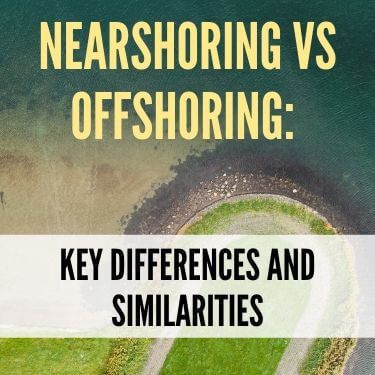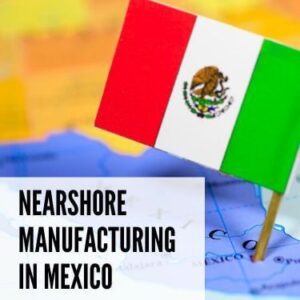
Por
 Copiar URL al Portapapeles
Copiar URL al Portapapeles
Nearshoring and offshoring might sound similar in principle - and they are - but there are profound differences in practice. Knowing about these differences can benefit your business enormously and help you develop a strategic approach to international operations while managing costs. What’s interesting about offshoring and nearshoring is that they both offer companies substantial benefits, but it’s not always clear which provides the most significant net gain. The one you choose requires complex decision-making at a high level, weighing the pros and cons of each and considering multiple important factors.
Choosing between nearshoring and offshoring is a major consideration. In short, both are considered a low-cost manufacturing alternative. Offshoring is handled further away from the destination point, while nearshoring is located closer to the final location where manufactured goods will be delivered. In addition to the geographic contrast between the two, there are other important differences.
The article below takes an in-depth look at both offshoring and nearshoring. After reading it, you’ll have the vital knowledge you need to decide which is right for your business.
Table of Contents
Offshore manufacturing refers to the production of goods and products that takes place a significant distance away from the place in which they’ll be sold.
Sometimes it doesn’t make sense to manufacture goods in one country when it is cheaper to do it in another. One such example is Western companies outsourcing production to places like Mexico. Medical device company Medtronic, for instance, does all of its high-value design work in the US and offshores manufacturing across the border where labor is cheaper. Once the devices are complete, these companies ship their medical devices from Mexico to the U.S. to be sold to consumers.
It’s worth noting that offshore manufacturing isn’t the same as “offshoring.” The term offshoring refers to any activity that a domestic company decides to carry out overseas. (For instance, it could offshore its marketing operations to a third party in Europe). Offshore manufacturing is merely a type of offshoring where companies use foreign facilities for production to bring costs down.
Offshore manufacturing is a crucial pillar of the modern, globalized world. Low barriers to trade between countries (and the availability of cheap labor) allow firms to seek out the lowest-cost opportunities. Western firms have created millions of low-skill jobs in emerging market countries with the primary beneficiaries today being China, Mexico, and even parts of Africa. Offshoring has enabled economies to take full advantage of specialization, with each country focusing on what it does best to enhance overall output and production efficiency.

Offshoring, however, isn’t the perfect solution. Nearshoring in manufacturing refers to the outsourcing of the production of goods, but at a closer geographic location than an offshoring country. For example, U.S. based company that manufactures goods in Mexico would be utilizing nearshoring vs offshoring by manufacturing the same goods in China. While offshoring does present a number of valuable benefits, nearshoring presents some unique advantages as well.
The first and most obvious is the time zone difference. A U.S. company like Apple that offshores production of iPhones to the Far East has to contend with a nine-hour time difference between head office and production facilities on the ground. This can prove to be challenging when conducting important discussion.
Another major concern is the language barrier. Because of the lack of cultural integration between the U.S. and China, few people in either country are fluent in the language of the other. Again, this makes it challenging to hold detailed meetings, hammering out production processes, company protocols, and production plans.
Offshoring tasks to places like China is also a substantial risk to intellectual property. The U.S. government investigated and imposed significant tariffs on China, citing the theft of IP has a major factor.
For this reason, many savvy companies in the US are exploring the idea of “nearshoring.” Nearshoring accepts higher wage costs by bringing production closer to home, but benefits from a variety of other factors that help to bring the overall cost down.
The benefits of nearshoring could include any number of the following:
Nearshoring, therefore, is an attempt to bypass some of the downsides of traditional offshoring, while keeping costs relatively low. Wage costs might not be as rock-bottom, but the overall savings could be more significant.
For a company to work effectively, the different parts need to be able to communicate with each other in real-time. Unfortunately, if vast time zones separate them, they’re not always able to do that. Workers in California, for instance, can’t easily pick up the phone and speak to operations managers in the Far East. Somebody, somewhere has to work a night shift and there’s often a significant drop-off in terms of quality.
Nearshoring, however, usually takes place in locations that are much closer in time. For U.S. companies, this means offshoring activities to countries closer to home. This can lead to having critical discussions quickly on the phone vs having delayed back and forth conversations through emails.
While the Far East is a popular destination for offshoring factory production, it’s important to note that it's not the only option. There are plenty of other middle-income countries that share the same time zone as the US that boast lower labor costs and offer business-friendly regulatory environments.
For many companies, Mexico is the obvious choice. It’s the most geographically proximate of all Latin American countries and, currently, shares mutually beneficial trade agreements with the U.S. For many firms, it makes sense to set up factories in Mexico along the southern border of the United States to keep logistics expenses to a minimum.
Physical proximity allows both better communication and problem-solving. Executives don’t have to fly halfway around the world to visit production facilities. Just a short-haul flight is all they need to inspect operations to their satisfaction. What’s more, language barriers are lower, making problem-solving much easier.

Ultimately, what most companies care about is the total cost of their operations, not the cost of any individual component. Unfortunately, the singular focus on wage costs can lead to some poor decision-making at the senior level. Company executives may decide to offshore production to the country that offers the lowest wage costs instead of the one that provides the best overall proposition.
Let’s say that you’re considering offshore manufacturing in China or nearshoring in Mexico. On paper, China might appear cheaper. Wage costs could be just $2 per hour compared to $6 in Mexico. But the $2 per hour isn’t the only cost that companies incur when they choose to outsource their production to a country like China. Sure, wages are lower, but so too are IP protections for the business. What’s more, shipping from China to the US is much more expensive than from Mexico.
To drive the point home, take a look at these additional costs of offshoring compared to nearshoring:
Manufacturing costs will likely be higher when nearshoring instead of offshoring, but lower transportation costs often offset them. Remember, the further that your goods have to travel, the higher the costs incurred.
Companies can spend years trying to build a practical, creative, and ethical culture. It’s an integral part of organizational identity and, when positive, a key differentiator.
Offshoring, however, can create some unforeseen problems. Just look at Apple’s experience with Foxconn.
Foxconn is a giant electronics assembly company based in China. Apple outsourced the assembly of its Apple iPhone to the company because of its low prices and ability to deliver enormous unit quantities in short order.
The problem came, however, when the cultures of the two companies collided. Apple is a progressive company interested in worker welfare. But Foxconn, according to some media reports, is not. The two companies are not natural siblings in this sense. Alleged poor treatment of workers at Foxconn’s factories is a smear on Apple’s otherwise excellent brand image.
Nearshoring, by contrast, provides a way for companies to protect the company culture they work so hard to nurture. By being physically and culturally closer to the offshore production facilities, maintaining standards is easier. Management can more effectively communicate with foreign staff, relay their expectations, and begin to grow a positive culture in the satellite facility.
Mexico is very much aligned with the U.S. in terms of languages spoken and attitude to business. While conditions might not be perfect, there are fewer barriers, making coordinating operations a lot easier.

Many firms who offshore the production of goods and services overseas must transport them vast distances to market. Often, shipping involves long and slow voyages across the world’s major oceans, creating delays and making it challenging to access goods.
Ideally, companies want short lead times between placing an order for a batch and receiving it in the target market. Waiting weeks for a ship to make its way across the ocean isn’t always the best solution.
Again, nearshoring rides to the rescue, offering the best of both worlds. Companies can both locate in countries with lower manufacturing costs and also deliver goods to the market much faster, often along roads instead of over the sea.
Being able to access goods quickly is a crucial consideration. The window of opportunity to make sales might be short. What’s more, your firm might need to get products to market faster than a competitor to take advantage of increased demand.
Having access to goods also makes them more manageable to inspect. If you’re waiting weeks for goods to arrive, you either have to visit the production facility itself or wait for products to arrive at a port, which again can take weeks.
In the late 2010’s, the U.S. has become more aware of the need for more production to take place domestically. Politically, the drive towards bringing American companies home is a powerful force. Many Americans want firms to relocate to the US and provide jobs to American citizens. They don’t want them outsourcing work to China and other countries in east Asia.
Some consumers view companies that offshore production to other countries in a negative light. American businesses should, in their view, employ American workers whenever possible. Many people show brand loyalty to enterprises that attempt to bring production closer to home. Production facilities just across the border have more positive ramifications for the local economy, assisting local communities both in the U.S. and its closer neighbors.
Nearshoring can benefit consumer perceptions in a variety of ways:
Businesses that conduct a large portion of their operations outside of the United States can often fall foul of consumers on both the left and right of the political spectrum. Many people want environmentally-responsible local production that reduces the harm to the environment while providing domestic workers with jobs. Others simply want American companies to serve the American people, not households and politicians in foreign lands.
Nearshoring, therefore, is as much a public relations device as it is an economic one. When companies nearshore their operations to counties that are within the sphere of influence of the U.S., they create positive sentiment in the market, and brand image. They align themselves with what the majority of their customers want. People want to support the local economy in North America - something that nearshoring allows them to do.

The advantages of manufacturing in Mexico are fairly significant. While there are many to choose from, a handful of them make nearshoring manufacturing in Mexico an attractive option.
Perhaps the most crucial of these is that Mexico shares time zones with the US. Manufacturing facilities in Mexico are operational at the same time as head offices north of the border. The geographical proximity assists with the ability to problem-solve with face-to-face meetings, and there are fewer cultural differences than with the Far East.
Mexico also has a large pool of cheap labor. The unemployment rate in Mexico is chronically high, which has the effect of pushing down wage rates in the country. American companies, therefore, can often hire workers for a fraction of the cost than they can in the U.S., where full employment pushes wages up. Estimates suggest that rates in Mexico are around 20 percent of what they are in the U.S.
The Mexican government benefits substantially from foreign companies hiring domestic workers and operating on the country’s soil. It has, therefore, made the business environment very attractive for international firms, offering special tax breaks. The political attitude towards business is also relatively positive in the company overall - far more so than in other parts of Latin America. Despite the relatively high price of electricity, it is one of the most promising places to establish a nearshoring effort.
Finally, companies choose nearshore manufacturing in Mexico because of the excellent digital and transport connectivity with the U.S. Mexico has several easy-access airports as well as several ports and train freight services. There’s also a major highway that connects the two countries - perfect for shipping large quantities of products north of the border.
If your company is considering manufacturing in Mexico, take a look at our article How to Find Manufacturers in Mexico. In this article, we provide you with valuable tips to locate the best manufacturers in Mexico.
With the benefits of nearshoring clear, many companies are choosing to relocate production south of the border. Here at R+L Global Logistics, we’re here to help your organization make that happen. Our cross border shipping services provide you with logistics assistance to move goods from the interior of Mexico to markets in the U.S, enabling you to experience all of the benefits of nearshoring while keeping distribution costs low.
At R+L Global Logistics, we’re fully committed to customer satisfaction, whether nearshoring and offshoring. Knowing what you want and what will work for your business is a part of our DNA. We work with you to think big and deliver big, providing you with a logistics partner to make your nearshoring objective a reality. We take a comprehensive approach to every business, providing services that you can count on every day. Thanks to our expertise working in the Mexican market, we’re the ideal cross border freight company to manage all of your shipping needs..
When you’re ready to get started give us a call at (866) 335-0495. We’ll happily provide with more and more information on how we can serve you and answer any questions that you have.
 Copiar URL en el Portapapeles
Copiar URL en el Portapapeles
